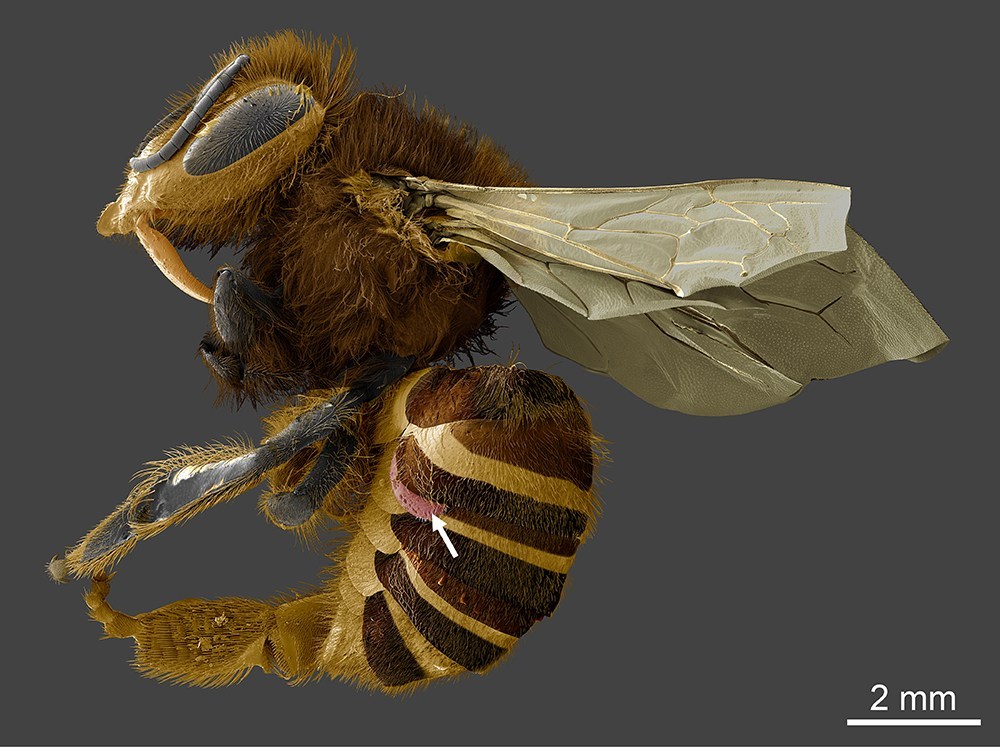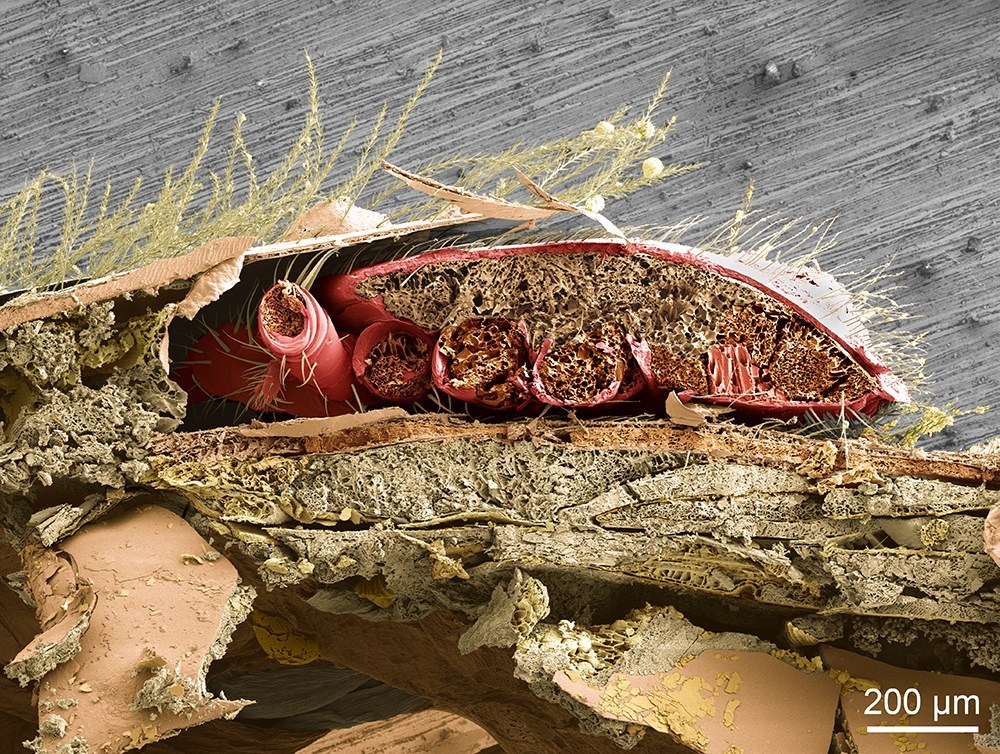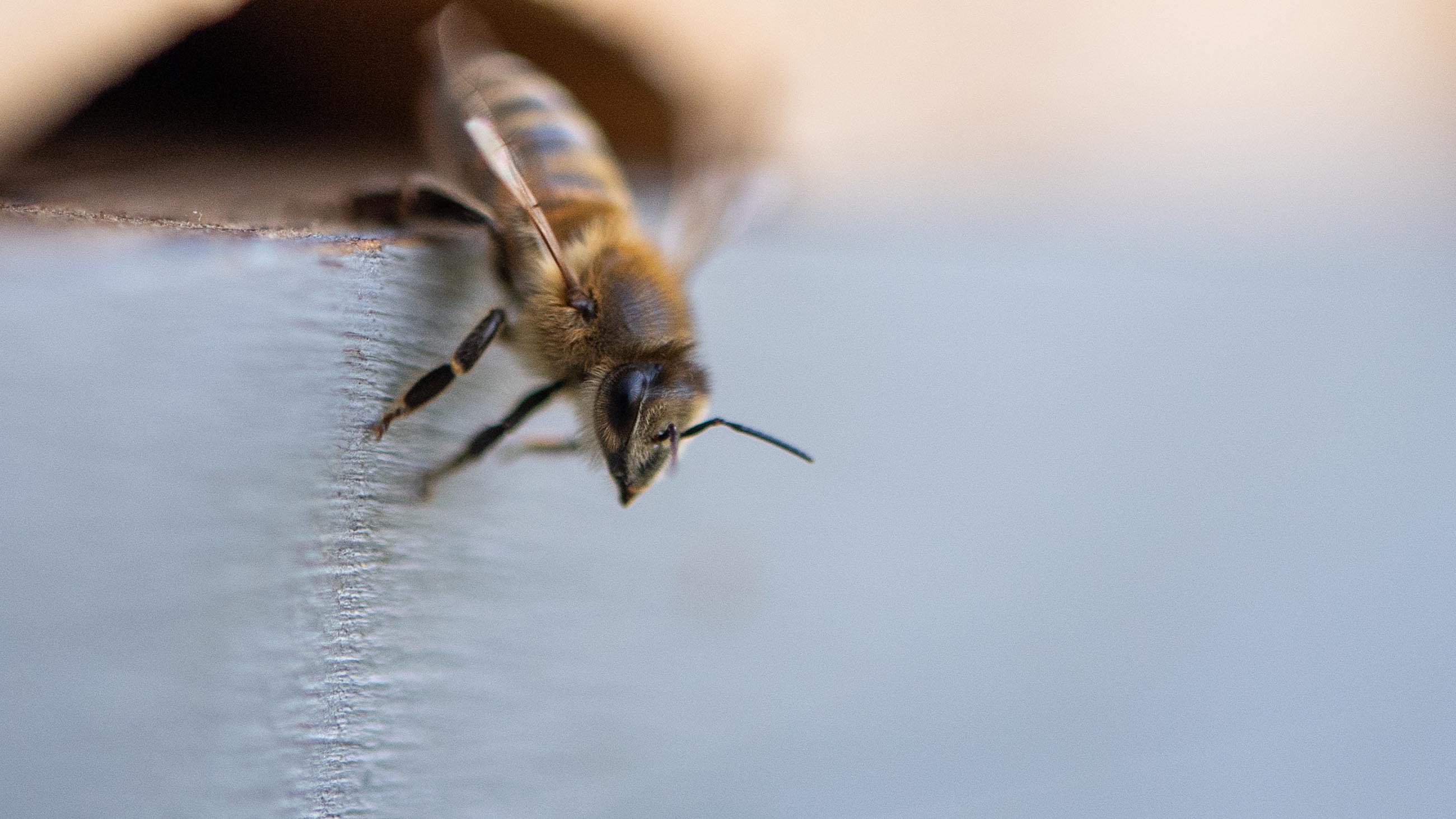The Honeybee’s Most Fearsome Enemy
Last January, California’s beekeepers were worried they wouldn’t have enough bees to pollinate the almond bloom, their biggest money-making event of the year. Gene Brandi, a California beekeeper and the former president of the American Beekeeping Federation, said winter losses were “as bad or worse than I believe it’s been.”
It turns out he was right. It was another grim year for America’s beekeepers, already reeling from more than a decade of colony losses that threaten the commercial honeybee industry. An annual survey released in June by the Bee Informed Partnership (BIP), a nonprofit collaboration of leading research labs and universities, found that beekeepers lost 38 percent of their colonies last winter, the highest winter figure since the survey began 13 years ago.
Managed honeybees play a crucial role in the nation’s food production, contributing an estimated $15 billion to the U.S. economy each year by helping to pollinate at least 90 crops.
Virtually everyone in the beekeeping business will tell you that the biggest threat facing honeybees isn’t pesticides, starvation, or even the mysterious affliction known as colony collapse disorder that made big news a dozen years ago. Instead, they’ll blame Varroa destructor, a parasitic Asian mite that snuck into the country more than 30 years ago. When asked to cite the three biggest risks to honeybees, Susan Cobey, a renowned expert on bee breeding at Washington State University, says, “Varroa, Varroa, Varroa.”
So far, the primary defense has been mite-killing pesticides known as miticides, but over time Varroa have developed resistance to some of them, and the beekeepers’ arsenal is diminishing quickly. “We think that Varroa are playing an increasing and very large role in these losses,” says Dennis vanEngelsdorp, a University of Maryland researcher working with the BIP. “In part because the products that are used to control them aren’t working as well, and also the viruses that they transmit are becoming more virulent.”
Even as Varroa continue to put enormous pressure on commercial beekeepers, and researchers work to breed bees that can better fight them off, another dangerous mite has been spreading in parts of Asia. If it arrives on our shores, it could push the beekeeping industry over the edge.

Honeybees aren’t native to North America; early colonists brought them over from Europe to provide honey and beeswax. Some of the bees escaped and took up life in the wild, spreading easily, a bit like the dandelions that also came over from Europe. These feral honeybees still live and breed as they did in their homeland and behave much like the 4,000 other species of wild bees living in the U.S. and Canada.
Over the following centuries, additional honeybees made their way over the Atlantic, but that stopped in the early 20th century after bees on the Isle of Wight off the coast of England began dying in epic numbers. Before long, the die-off spread to other parts of Europe. In 1922, in an effort to keep the disease from reaching the U.S., Congress passed the Honeybee Act, shutting the doors to importation of all honeybees.
For more than 60 years, the ban seemed to work, but in 1984 the tracheal mite blamed for the Isle of Wight disease arrived, followed three years later by its more deadly cousin, Varroa destructor. Both mites swept across the country in less than a decade, killing both managed and feral colonies. The honeybees quickly adapted to the tracheal mites, but not to Varroa.
Female Varroa mites lurk in the darkness of a honeybee hive, waiting for the right moment to slip into the wax cells where young bees spend their youth, growing from egg to larva to pupa to adult. As larvae, the bees are ravenous, and their adult sisters, the nurse bees, visit them and provide food more than a thousand times a day. As a larva approaches its next life stage, it sends out a pheromonal signal; the nurse bees know they’ll soon need to put a waxen cap on the cell, so the young bee can complete its metamorphosis.
The problem is that the scent signal also reaches the Varroa mites, who enter the cells and hide under the larval bees’ goopy food, sending up a snorkel so they can breathe. After the cells are capped, a mite will give birth, her daughters will mate with their brothers, and the whole family will have up to two weeks to feed on the unguarded bee.
For decades, scientists thought the mites were like ticks — blood suckers that inject diseases. Research published in January, however, found that the mites actually consume a bee’s “fat body,” tissue that plays a vital role in both its immune system and its ability to detox pesticides.
That discovery opens up new possibilities for developing more effective miticides. Samuel Ramsey, who conducted the fat body research as part of his dissertation in vanEngelsdorp’s lab at the University of Maryland, says, “the holy grail is to add some sort of miticide into the feed of the bees” that could be absorbed in the fat body. But the problem is that the mites can develop miticide resistance, as some already have.
In light of recent colony woes, the USDA’s Agricultural Research Service has been conducting field trials to see whether researchers can breed mite-resistant bees. (Video by USDA-ARS)
A more promising long-term solution is to develop bees that can fend off Varroa themselves, which is the one of the goals of the U.S. Department of Agriculture (USDA), among others.
“We jumped into Varroa pretty seriously,” says Bob Danka, the research leader at the USDA’s Honey Bee Lab in Baton Rouge, Louisiana, adding that the mite “has really been our focus for 20 years.”
As part of their research, the lab began looking around the world for bees that had developed ways of co-existing with the mites, finding some likely candidates in eastern Russia.
The agency had to get a permit because of the Honeybee Act restrictions, and imported some Russian bees, which they quarantined on an island in the Gulf of Mexico to confirm that the bees were indeed able to prevent Varroa from killing off a colony.
One way bees can deal with Varroa is by taking the caps off larval cells and removing the mites. It seems straight-forward, but not all bees do it. They can also bite mites off of adult bees. These actions are genetic and bees that display these kinds of behaviors — like the Russian ones — are called Varroa-resistant. They are not, however, Varroa-proof and can still be overrun by too many mites.
Eventually, the USDA released the Russian bees to industry, and later they and others brought out more Varroa-resistant lines, none of which have taken hold with most commercial beekeepers, who still choose to use bees that are easily overtaken by mites.
Danka cites several reasons for their reluctance to change. First, many beekeepers believe they already have a workable —if not totally effective — solution for Varroa: a miticide called amitraz. “If amitraz resistance develops, it will be another huge paradigm shift,” Danka warns. “But right now, amitraz works. And if you are a farmer, which is what a beekeeper is, you are risk averse.”
Ultimately, however, “There’s a great fear that the amitraz product is going to fail,” Danka says.

Second, maintaining Varroa resistance in multiple generations of bees is surprisingly difficult, in large part due to the nature of honeybee sex. Queens mate with 10 to 20 random males they meet while out flying, which means Varroa-resistant genes tend to dissipate quickly unless all those random males happen to be Varroa-resistant too.
Finally, beekeepers are seeking more than just Varroa resistance. They want bees that can make it through the winter with a large population that is ready to spring into action when crops like almonds bloom. They also want bees that are gentle, excellent honey producers, and resistant to pests and diseases other than Varroa.
“In a beekeeper’s mosaic world, it is just one little facet,” Danka says.
Currently, no bee with all those traits is on the market, but a professional group that includes beekeepers, a bee breeder, the USDA, and Project Apis m., a nonprofit that supports honeybee research, is in the third year of trials on a line of bees that may eventually fit the bill.
Given the variety of risks to honeybees, Varroa-resistant bees won’t fix everything. But deploying them as part of a larger strategy to protect colony health is critical, since another parasitic Asian mite, Tropilaelaps, may one day pose an even greater threat.
For a while, researchers thought Tropilaelaps could only survive in the tropics. But now the mites have been found in colder parts of South Korea and the Himalayas. “Nothing is making sense for how they get through the winter yet, but we’re not safe in North America just because of our long winters anymore,” says Jeff Pettis, the former research leader for the USDA’s Bee Research Laboratory in Beltsville, Maryland. “We thought we were, but we’re not.”
Asian beekeepers who deal with both mites worry more about Tropilaelaps than Varroa, and recent research found that amitraz, the current go-to miticide in the U.S., doesn’t work on Tropilaelaps.
“If these mites arrive in the U.S., it will be devastating, like what Varroa mites are doing to the industry,” says Lilia De Guzman, a researcher at the USDA’s Honey Bee Lab in Baton Rouge. She notes that Varroa feed from just one spot on a larva while Tropilaelaps may make multiple wounds: “I’ve never seen that horrific damage on bees infested with Varroa mites.”
For Pettis, the biggest concern is that Varroa-resistant bees won’t necessarily be effective against Tropilaelaps if they somehow make the jump to the U.S.
Meanwhile, some beekeepers aren’t waiting for a well-tested Varroa-resistant bee. They’re trying a Darwinian approach by stopping miticide use. It’s a risky option when your livelihood depends on the bees. Nevertheless, Pettis says, “I’ve heard about a few big commercial beekeepers that have said, ‘I’m treatment free now. I’m taking my losses whatever they are now, it doesn’t matter.’ Because if you’re already losing 30 to 50 percent, it can’t get that much worse.”
Paige Embry is a freelance journalist who has written for Scientific American, Huffington Post, the Food and Environmental Reporting Network, and Entomology Today, among other publications. She is the author of “Our Native Bees: North America’s Endangered Pollinators and the Fight to Save Them.”











Comments are automatically closed one year after article publication. Archived comments are below.
Perhaps I can help… I’m sure that your tests results would show commercial protocol of chemicals and genetic selection would give you positive results. The tests are designed to do that. Well done. Now if we are really going to look at the true enemy of the honey bee you’ll have to look at you funders… yep.
Now what do we mean? Well lets just say you broadened your scope to take into consideration why we need to toxify and genetically alter the commercial honey bee… we transport billions of honey bees into large scale chemically sustained monoculture croplands that are thousands of acres in size where they are expected to pollinate billions of blossoms taking both pollen and nectar back to the hive. Unlike all other pollinators who exist on a fast food diet, bouncing from bloom to bloom consuming along the way and bringing some back to the hive for the rest… honey bees grocery shop. They visit the blooms and bring back protein and carbohydrates to convert into bee bread and honey. They grocery shop and have meals prepared by bees caste as chefs to make specialized meals for each class of bee: guard, builder, nurse, forager, undertaker… Commercial beekeepers truck their colonies across the country/planet to follow the blooms to make money providing pollination services as Spring springs across the globe. Now beekeepers also harvest honey from those traveling hives and they are paid a high price for varietals like orange blossom, blueberry, raspberry, apple, almond etc… so rather than give that hard earned honey to the bees who made it, they pull it off and feed them corn syrup and beet sugar… because its cheap… but also chemically saturated. Now you want to do a real study.. analyse the food substitutes and run it against test hives left to consume their own honey… then test those industrial diet honeys with wild hives not near too much agribiz acreage. If ya feed honey bees tainted food… roundup ready corn syrup… it is not going to be as healthy as a bee left to eat its own clean honey. Thats the test you need to do. Heck try testing urban bees and honey compared to the commercial bees. Also realize our limited knowledge of genetics seems impressive… but we are in the infancy of development of CRISPR and genetic splicing/sequencing understandings… as we make sisters of sisters cloning our favorite features and traits, we are winnowing genetics of resilience, seasonal activities and cold weather hardiness in favor of abundant fertility, chemical resistance, and forage efficiency. That practice has never been studied against a treatment-free hive. I this helpful?
I really liked what you had to say.
Excellent points. It seems to me the mono-cropping and transporting of bees will have to stop especialy since, based on history, we ARE going to see the Tropilaelaps mite here, later or sooner. It will happen. When it does, transporting bees should be illegal and mono-cropping will be beyond foolish.
please research Paul stamets and protecting our bees using certain mushrooms such as Rishi chaga and I believe agarikon and there are a few others that are very bought beneficial to completely just about inoculate and completely help Arby’s conquer the varroa Mite and the other short Wing disease
A huge problem has occurred with the lack of proper mating of the queens due to low sperm count or damaged sperm from the drones.
The result can be seen in the lack of time the queens are able to produce worker brood before they become drone layers.
The varroa mites prefer to use drone cells for laying and they lay more young mites in each of those cells which results to more predation damage to the individual drone pupa.
Superficially the hatching drones may appear healthy and well formed, but they may not up to the task.
Drones have a propensity for drifting between colonies and are very probably largely responsible for the rapid spread of the mites in an apiary.
I have witnessed a drone feeding on a dandelion flower, so how far can those powerful drones fly from their mother hive given that they can to some extent feed themselves?
I don’t like the idea of line breeding using artificial insemination of virgin queens , but it seems to be a possible means of producing better fertile queens from mite free colonies.
Amen to that. The biggest problem on this planet are the entitled, first world consumers and the industries that exist to feed them.
do you think the color yellow on the bees attracts the Asian mites maybe different cent and look change color of bee does it go after black bumble bees ?it was carred from a yellow asian bird probably carryed over hear or yellow fruit something yellow im guessing
Would oxalate containing crops, being planted nearby to where bees live – such as rhubarb, peanuts and other varieties of plants which harbor high levels of oxalic acid naturally – if allowed to “flower” instead of being grown solely for the crop harvest value … would there be a resistance that could occur over time that could help the bees rid the mites = in conjunction with the formic acid angle as shown in Belgium by the commentator? We often do little or no companion planting, with agriculture’s focus on monocultures. I suspect of course if pests were encouraged to occur and be taken care of by companion planting’s mindset to attract various species of insects which have their predators feeding on the companion plants that are nearby – this way of going “backward in time” in planting crops and flowering plants — indeed might make a difference …
It seems that some destructive things…
It seems that many destructive things have come from asian countries, the japanese beetle, the asian carp, the asian mite, metal eating sheet rock….etc
&/Or MORE all-consuming ambition, a flaw of humanity we might want to breed out of ourselves!
This might be of interest to this discussion https://www.nature.com/articles/s41598-017-07290-w
Is there a project that is treating the mite? Mosquitoes are are breeding with asexual mosquitoes maybe something like that can be done with the mites.
just coat the bees with chili powder and give those varroa a seasoning lol
I began keeping bees a decade ago with the intent, by being completely organic, even if it entailed losses, to try to strengthen the stocks. The italian bees we now use have been bred over time to encourage less aggressive behaviors, for our convenience. What I read about the varoa issue is that there is a correlation between the aggressiveness of a type & its ability to fight these parasites. It is my understanding that the African bees, considered a “scourge” because of their aggressiveness, have almost no issue with this problem. (check out “The Monk & the Honeybee-old probably not even on dvd). The Russians mentioned in this article are also a more aggressive strain…not as easy or convenient to deal with. Another issue is, again, for our convenience…the square box of frames we require bees to live in is not their natural structure…in winter, left alone, bees form a big ball in their solid hive structures & rotate from inner to outer for warmth…small bodies that have to crawl away from the cluster, which isn’t even really a cluster when it is separated by frames stun quickly in cold. I had no losses with my Russians when I removed 4 frames in the center of the box & allowed them to make their own natural comb structure. But then, that forces the beekeeper to leave the hive intact, with its honey as intended, for the bees, which, in commercial beekeeping, are usually living on sparse stores, sugar candy, or even corn syrup as their honey has been harvested & sold. Bees are also extremely sophisticated in their orientations, not well understood. When 100’s of hives are trucked around the country for short periods of time, the stress weakens all (who survive) & it has to affect the genetics in time. The truth is, we have done to the honeybee what we have done to our domesticated meat animals. THAT is the real issue here…all the rest is like the hot air being added to the already warming planet by the endless “climate summits” where the can is kicked a bit further down the road & nothing of import is really done…& like the global environmental situation, the honeybee situation is pretty close to the end of that road…& we are still trying to fix what we have created without making the real changes required, because they would impact the “bottom line” & convenience they were created for in the beginning.
What about scientist mutate a bees to where they have no stinger so that people will stop being scared of them, and we all start harvesting and mainlining our own harvest…. If bees are as to regulars flies, a pest but not feared or scary nor causes any harm, Make it mandatory for certain number of people to harvest an maintain a colony all over us, BAM!! We be like Winnie the poo honey plenty for me an you an duh Winnie pooh too
Creo que hay que desarrollar armas biológicas contra estos ácaros que atacan a las abejas. Los virus serían un buen vector a través de los mosquitos. Naturalmente deberían ser inocuos en humanos. Hay que desarrollar la Virología para poder hacerlo.
Thank you for an unusually accurate and up-to-date article about honeybees and the varroa problem.
I’m completely digread whith yours explication. This is relations bitwing waroa might and immunity of bee’s. But second very important matter is nosema ceranae. Destroying malphigiel tubules, bee’is not able to eliminate waste product of hemolymha. Creating levels going to up. Living days dropped of 12 to 14 days. According my opinion, this is CCD. It’s the same as humans. If the kidney function is out, after 5 days the humans will day. Entomologist (doctor s) most to say Howe to eliminate this fungal. This 2 prevent must be applicate in same time.
I believe Bees can naturally overcome nosema ceranae, and it is present in many hives observable by brown streaks on the outside of the hive. This is a sort of bee “diahrrea” if I understand right. The problem with Varroa is that they thrive in the hive environment and reach peak around the time the hive begins to shrink towards winter. This is why they are so problematic.
Where I am from, Luxembourg, treatment chemicals we use are; Formic acid (80%) and Oxalic acid (80%). This treatment seems to work well and I am wondering if perhaps it is more difficult for the mites to develop a resistance to the “natural” acids?
Excuse my lack of understanding, but I wonder if the focus shouldn’t remain on the Varroa mite itself. If it can’t be consistently controlled with miticides, could it be genetically impaired to propagate a pheromonal deficiency? Would that result in leaving the honeybee population alone?
I think you have the right idea, but what do I know I’ve only been keeping bees for 40+ years, I also believe if we don’t change the way I grow culture is done in this country we’re going to continue to stress out and we can Arby’s to the point of no return.
but the smart ones will get the job done. After that, tropilaelops.
The problem isn’t just Varroa (both of them, or as we see all threeof them). It is multi vectoral…lack of forage as first, monoculture crops everywhere. Even simple backyard grasses can’t have some clover or dandelions. Then all kind of herbicides and pesticides that aren’t used per their label…. If we add climate change and current “commercial” approach to beekeeping… Yes, disaster and die off.
Pesticide use on our lawns and in our gardens pose a major threat to hobbyist beekeepers in our suburbs. The bees pick up the chemicals on the plants and bring them back to the hive. It is stored in the wax where it can impact many generations of honey bees.
Here in Brazoria County Texas not only is it pesticides used on lawns and in gardens not to mention crops, but one of our biggest concerns is the overuse of pesticides by the County Mosquito spraying, they have a bunch of to meet of roughly 3.7 million dollars, it’s on a use-it-or-lose-it basis
The problem is “commercial beekeeping”. Bees are stressed from our desires. Left alone and not moved from point to point they would be better off. When money is on the table, leave it to man’s greed to eff things up.
Bill, I tried to see if the data supported this, but as far as I could find the commercial beekeepers had lower losses than average: https://bip2.beeinformed.org/survey/
Could you help me better understand your position?